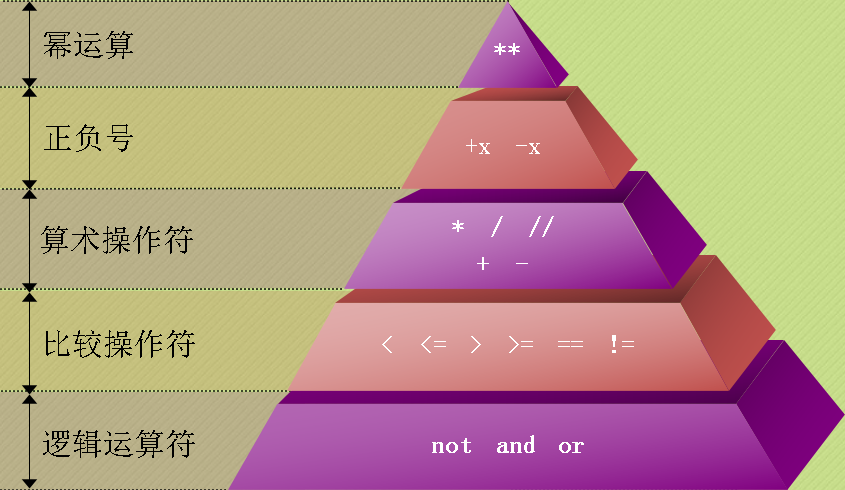--: 作者:不知百度知 2022年9月
[TOC]
## 1. if三元表達式(三元運算符)
### 1.1 說明
使用一行代碼快速判斷,更換復雜的多行if語句,使代碼能夠簡單地維護。
### 1.2 其它語言的三元表達式
> 判段的條件 ? 條件為真時的結果:條件為假時的結果
```java
public class java {
public static void main(String[] args){
int x = 100;
int y = 101;
int MAX = (x > y)? x: y;
System.out.println("MAX:" + MAX);
}
}
```
### 1.2 python的三元表達式
> 條件為真時的結果 if 判段的條件 else 條件為假時的結果
```python
x = 4
y = 99 if x > 3 else 999
```
## 2. 變量的真假
在 Python 看來,只有變量的值為0或空、長度為0時,才會被看作假(注意引號、括號里邊啥都沒有,連空格都不要有!):
` False None 0 "" '' () [] {} `
其他一切都被解釋為真!
測試示例:
```
if 0:
print('True1')
else:
print('False1')
if "":
print('True2')
else:
print('False2')
if []:
print('True3')
else:
print('False3')
if {}:
print('True4')
else:
print('False4')
if ():
print('True5')
else:
print('False5')
```
結果為
```
False1
False2
False3
False4
False5
```
所以我們經常會見到別人的代碼這樣判斷
```
if 變量:
xxx
```
比如:
```
a = 10
if a: # a大于0,條件為真
a -= 1
else:
a = 10
```
## 3. 短路邏輯(short-circuit logic)
邏輯操作符有個有趣的特性:在不需要求值的時候不進行操作。
<div style='height:20px'></div>
這么說可能比較“高深”,舉個例子,表達式 x and y ,需要 x 和 y 兩個變量同時為真 (True) 的時候,結果才為真。
<div style='height:20px'></div>
因此,如果當 x 變量得知是假 (False) 的時候,表達式就會立刻返回 False ,而不用去管 y 變量的值。
這種行為被稱為短路邏輯( short-circuit logic )或者惰性求值( lazy evaluation )。
<div style='height:20px'></div>
這種行為同樣也應用于 or 操作符,Python 的做法是如果 x 為假,表達式會返回 x 的值 (0) ,否則它就會返回 y 的值。
```
a = 3 and 4 # 結果為4
b = 3 or 4 # 結果為3
```
## 4. 對象的類型判斷
- type(對象) == 類型
- isinstance(對象, 類型)
python中type可以獲得一個對象的數據類型,isinstance可以判斷一個對象的數據類型,他們的區別有兩點:
### 4.1. isinstance更加靈活
type只是返回一個對象的數據類型,而isinstance可以判斷這個對象的數據類型是否為某幾個數據類型中的一個。
假設我們要判斷一個對象的數據類型是否為int或者float,兩個函數的寫法示例如下
~~~python
a = 4
# 使用type
if type(a) == int or type(a) == float:
print('yes')
# 使用isinstance
if isinstance(a, (int, float)):
print('yes')
~~~
顯然,在這種場景下,isinstance更有優勢
### 4.2. 判斷存在繼承關系的情況
~~~python
class A:
pass
class B(A):
pass
a = A()
b = B()
print(type(b) == A) # False
print(isinstance(b, A)) # True
~~~
B是A的子類, type(b)返回的是類B, 不等于A, 但B是A的子類,因此,我們可以認為b也是A的對象,面對這種存在繼承關系的情況,應當使用isinstance。
官方推薦用第二種方法判斷變量的類型,現在先有個初步印象,學到后面再作詳細解釋。
## 5. 運算符優先級
以下表格列出了從最高到最低優先級的所有運算符:
| 運算符 | 描述 |
| --- | --- |
| \*\* | 指數 (最高優先級) |
| ~ + - | 按位翻轉, 一元加號和減號 (最后兩個的方法名為 +@ 和 -@) |
| \* / % // | 乘,除,取模和取整除 |
| \+ - | 加法減法 |
| \>> << | 右移,左移運算符 |
| & | 位 'AND' |
| ^ | | 位運算符 |
| >= | 比較運算符 |
| <> == != | 等于運算符 |
| \= %= /= //= -= += \*= \*\*= | 賦值運算符 |
| is is not | 身份運算符 |
| in not in | 成員運算符 |
| not and or | 邏輯運算符 |
常見幾種類型運算符優先級示意圖

> 練習
- 請用最快速度說出答案: not 1 or 0 and 1 or 3 and 4 or 5 and 6 or 7 and 8 and 9
<div style='height:100px'></div>
not or and 的優先級是不同的: not > and > or,我們按照優先級給它們加上括號:
```
(not 1) or (0 and 1) or (3 and 4) or (5 and 6) or (7 and 8 and 9)
== 0 or 0 or 4 or 6 or 9
== 4
```
【Tip】
溫馨提示:為了更好的表達你的程序,有些括號還是不能省下的,畢竟不是所有程序員都跟你一樣都將優先級爛透于心的。
- 一、Python基礎
- 1. 序言
- 1.1 Python簡介
- 1.2 安裝和使用IDE
- 1.3 語言特性和基礎概念
- 2. 基本數據類型
- 2.2 字符串型
- 2.2.2 ASCII簡介
- 2.2.4 字符串常用函數
- 3. 條件分支
- 3.3 閑聊條件判斷和運算符優先級
- 10.正則表達式
- 【降龍十八章】Python小技巧
- 18.1 學習網址
- 18.2 PIP切換源
- 18.3 使用whl來安裝
- 【工具優化】IDE優化技巧
- Anaconda
- Jupyter Notebook 的 Markdown 添加大綱
- Jupyter Notebook中圖片縮放和居左
- Anaconda設置環境變量
- Pycharm
- PyCharm新建文檔配置
- 設置字體和字號
- 設置主題和字體配色
- 保存和導入配置
- 設置對選擇內容自動添加引號
- 推薦安裝的插件
- Markdown
- 表格格式
- 二、Python進階
- copy和deepcopy
- 《零基礎入門學習 Python 》【小甲魚版】
- 001.和Python的第一次接觸+習題復習
- 002.用Python設計的第一個游戲 +習題復習
- Pygame詳解
- Pygame詳解:前言
- Pygame詳解(一):Color類
- Pygame詳解(二):display 模塊
- Pygame詳解(三):draw 模塊
- Pygame詳解(四):event 模塊
- Pygame詳解(五):font 模塊
- Pygame詳解(六):image 模塊
- Pygame詳解(七):key 模塊
- Pygame詳解(八):locals 模塊
- Pygame詳解(九):mixer 模塊
- Pygame詳解(十):mouse 模塊
- Pygame詳解(十一):Rect 對象
- Pygame詳解(十二):Surface 對象
- Pygame詳解(十三):time 模塊
- Pygame詳解(十四):music 模塊
- Pygame詳解(十五):pygame 模塊
- Pygame詳解(十六):cursors 模塊
- Pygame詳解(十七):joystick 模塊
- Pygame詳解(十八):mask 模塊
- Pygame詳解(二十一):BufferProxy 對象
- Pygame詳解(二十三):gfxdraw 模塊
- Pygame詳解(二十五):Overlay 對象
- Pygame詳解(二十八):sndarray 模塊
- Pygame詳解(三十一):camera 模塊
- Pygame詳解(三十二):cdrom 模塊
- Pygame詳解(三十六):version 模塊
- pygame rect相關知識
- Tkinter詳解
- Tkinter 組件詳解(一):Label
- Tkinter 組件詳解(二):Button
